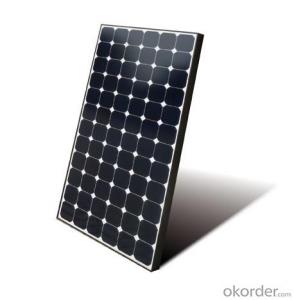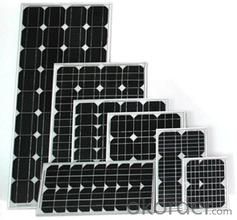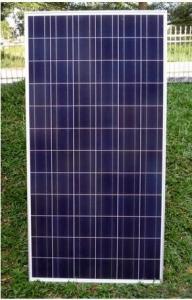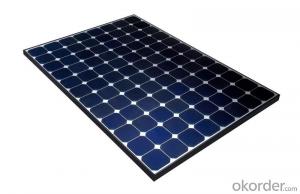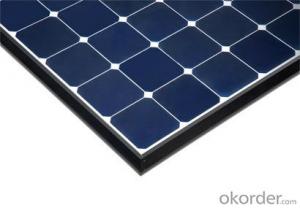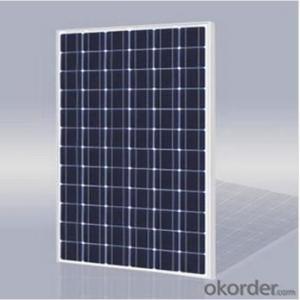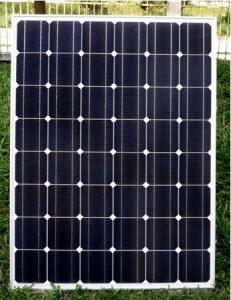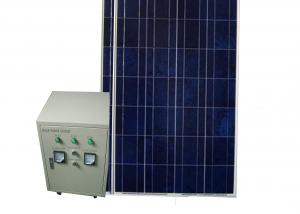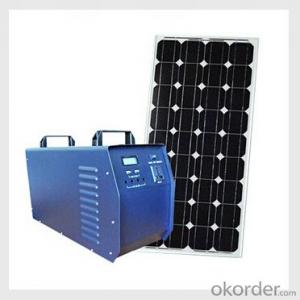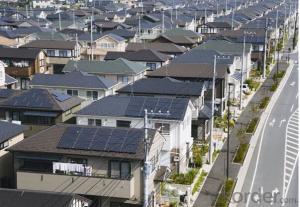Solar Energy Systems Peoria CNBM On Grid System 2000W with Certificate UL TUV CE
- Loading Port:
- Shanghai
- Payment Terms:
- TT OR LC
- Min Order Qty:
- 100 watt
- Supply Capability:
- 1000 watt/month
OKorder Service Pledge
OKorder Financial Service
You Might Also Like
Specification
CNBM On Grid System 2000W with Certificate UL TUV CE
Product description
They range from small residential and commercial rooftop systems to large utility-scale solar power stations. Unlike stand-alone power systems, a grid-connected system rarely includes an integrated battery solution, as they are still very expensive. When conditions are right, the grid-connected PV system supplies the excess power, beyond consumption by the connected load, to the utility grid.
Connection of the photovoltaic power system can be done only through an interconnection agreement between the consumer and the utility company. The agreement details the various safety standards to be followed during the connection.[4]
Systems such as Net Metering and Feed-in Tariff which are offered by some system operators, can offset a customers electricity usage costs. In some locations though, grid technologies cannot cope with distributed generation feeding into the grid, so the export of surplus electricity is not possible and that surplus is earthed.
Grid-connected PV systems are comparatively easier to install as they do not require a battery system.[1][6]
Grid interconnection of photovoltaic (PV) power generation systems has the advantage of effective utilization of generated power because there are no storage losses involved.[7]
A photovoltaic power system is carbon negative over its lifespan, as any energy produced over and above that to build the panel initially offsets the need for burning fossil fuels. Even though the sun doesn't always shine, any installation gives a reasonably predictable average reduction in carbon consumption.
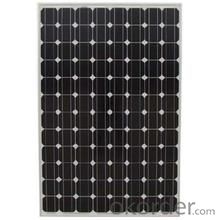
Application
Industrial
Commercial
Residential
Feature
Residential, grid-connected rooftop systems which have a capacity more than 10 kilowatts can meet the load of most consumers.[2] They can feed excess power to the grid where it is consumed by other users. The feedback is done through a meter to monitor power transferred. Photovoltaic wattage may be less than average consumption, in which case the consumer will continue to purchase grid energy, but a lesser amount than previously. If photovoltaic wattage substantially exceeds average consumption, the energy produced by the panels will be much in excess of the demand. In this case, the excess power can yield revenue by selling it to the grid. Depending on their agreement with their local grid energy company, the consumer only needs to pay the cost of electricity consumed less the value of electricity generated. This will be a negative number if more electricity is generated than consumed.[3] Additionally, in some cases, cash incentives are paid from the grid operator to the consumer.
Packaging
With carton and box
- Q: Can solar energy systems be used for desalination?
- Yes, solar energy systems can be used for desalination. Solar-powered desalination plants use solar energy to power the desalination process, typically through the use of solar panels or solar thermal collectors. This renewable energy source can be harnessed to convert saltwater into fresh water, making it an environmentally friendly and sustainable solution for water scarcity in coastal and arid regions.
- Q: How do solar energy systems impact regional economic development?
- Solar energy systems have a positive impact on regional economic development in several ways. Firstly, they create job opportunities in the installation, manufacturing, and maintenance sectors. This leads to increased employment rates and income levels, stimulating economic growth. Secondly, by reducing reliance on fossil fuels, solar energy systems lower energy costs for businesses and households, freeing up funds that can be invested in other sectors. Furthermore, solar projects attract investment and promote innovation, fostering a sustainable and resilient economy. Overall, solar energy systems contribute to job creation, cost reduction, and investment attraction, all of which drive regional economic development.
- Q: Can solar energy systems be used in conjunction with backup generators?
- Yes, solar energy systems can be used in conjunction with backup generators. In fact, this combination can provide a more reliable and efficient power supply. Solar energy systems harness energy from the sun and convert it into electricity, which can power homes, businesses, or other facilities. However, solar panels only generate electricity when the sun is shining, so they may not be able to meet the power demands during cloudy days, at night, or during power outages. This is where backup generators come in. A backup generator is a device that can provide electricity when the main power source is unavailable or insufficient, such as during blackouts or when the solar energy system is not producing enough power. By integrating a backup generator with a solar energy system, it ensures a continuous and reliable power supply regardless of weather conditions or grid disruptions. When solar panels are generating excess electricity, they can charge batteries that store the energy for later use. During periods of low solar production or high energy demand, these batteries can be utilized to power the premises, reducing the need for the backup generator. However, in situations where prolonged cloudy days or an extended power outage occurs, the backup generator can kick in and provide the necessary energy to keep the lights on and essential appliances running. This combination of solar energy systems and backup generators offers the benefits of renewable energy and energy independence, while also providing a backup power source when needed. It is especially useful for areas with unreliable grid infrastructure or regions prone to natural disasters. Additionally, this integration allows for better management of energy usage, potentially reducing electricity costs and minimizing fossil fuel consumption.
- Q: Do solar energy systems require surge protection?
- Indeed, surge protection becomes imperative when it comes to solar energy systems. The susceptibility of these systems to power surges caused by lightning strikes, grid fluctuations, or other electrical disturbances necessitates the presence of surge protection. The fragile electronic components of a solar energy system, like inverters or charge controllers, can be severely compromised or even annihilated by power surges. Hence, the deployment of surge protection devices, such as surge protectors or surge arresters, is crucial in diverting excessive voltage away from the system, thereby safeguarding it from harm and ensuring its durability. Furthermore, the inclusion of surge protection is often mandated by electrical codes and regulations to guarantee the safety and dependability of solar energy systems.
- Q: Are there any limitations to using solar energy for powering vehicles?
- Yes, there are limitations to using solar energy for powering vehicles. Some of the main limitations include the intermittent nature of solar power, as it is dependent on weather conditions and daylight availability. This makes it challenging to consistently generate sufficient energy for continuous vehicle operation. Additionally, solar panels take up a significant amount of space, which can be impractical for smaller vehicles with limited surface area. Moreover, the energy conversion efficiency of solar panels is relatively low, resulting in less power output compared to conventional fuel sources. Lastly, the initial installation cost of solar panels and the associated infrastructure can be expensive, making it less economically viable for widespread adoption in the automotive industry.
- Q: How do solar energy systems contribute to reducing greenhouse gas emissions?
- Solar energy systems contribute to reducing greenhouse gas emissions in several ways. Firstly, they generate electricity without burning fossil fuels, which are the primary source of greenhouse gas emissions. By relying on the sun's energy, solar systems eliminate the need for power plants that release carbon dioxide and other pollutants. Secondly, solar energy reduces the demand for traditional electricity generation, which often relies on fossil fuels. As solar power becomes more widespread, the overall carbon footprint of the energy sector decreases. Lastly, solar energy systems can be integrated into buildings, reducing the need for energy transportation and transmission, which further minimizes greenhouse gas emissions. Overall, solar energy systems play a crucial role in transitioning to a cleaner and more sustainable energy future, helping to combat climate change and reduce greenhouse gas emissions.
- Q: Can a solar energy system be installed on a ground-mounted structure?
- Yes, a solar energy system can be installed on a ground-mounted structure. Ground-mounted solar systems are a popular option for residential, commercial, and utility-scale installations. These systems involve placing solar panels on a structure that is built on the ground, such as a pole, rack, or frame. Ground-mounted systems have several advantages, including flexibility in panel placement, easier maintenance and cleaning, and the ability to optimize the angle and orientation of the panels for maximum energy production. Additionally, ground-mounted systems can be installed in areas where rooftop installation is not feasible, such as properties with limited roof space or shading issues. Therefore, installing a solar energy system on a ground-mounted structure provides an effective and efficient way to harness solar power.
- Q: Can a solar energy system be installed on a government building or facility?
- Yes, a solar energy system can be installed on a government building or facility. In fact, many governments worldwide are actively promoting the adoption of renewable energy sources, including solar power, in order to reduce their carbon footprint and achieve sustainability goals. By installing solar panels on government buildings, they can generate clean and renewable electricity, reduce dependence on non-renewable energy sources, and potentially save money on energy costs in the long run.
- Q: Can solar energy systems be used in areas with high humidity?
- Yes, solar energy systems can be used in areas with high humidity. Humidity does not directly affect the generation of solar power as it is the sunlight that is utilized by solar panels to produce electricity. However, it is important to maintain and clean the solar panels regularly in high humidity areas as moisture can accumulate and reduce their efficiency.
- Q: Can solar energy systems be used for powering electric boat charging stations?
- Yes, solar energy systems can indeed be used for powering electric boat charging stations. Solar panels capture sunlight and convert it into electricity, which can then be used to charge the batteries of electric boats. By installing solar panels on the roofs or nearby areas of the charging stations, the energy produced can directly power the charging infrastructure. This not only makes the charging stations environmentally friendly by utilizing renewable energy, but it also reduces dependence on the power grid, making them more independent and sustainable. Additionally, using solar energy for electric boat charging stations can also help reduce operating costs in the long run, as the electricity generated from solar panels is free once the initial installation costs are covered.
Send your message to us
Solar Energy Systems Peoria CNBM On Grid System 2000W with Certificate UL TUV CE
- Loading Port:
- Shanghai
- Payment Terms:
- TT OR LC
- Min Order Qty:
- 100 watt
- Supply Capability:
- 1000 watt/month
OKorder Service Pledge
OKorder Financial Service
Similar products
Hot products
Hot Searches
Related keywords
